How the early printing press became a commercial success
Gutenberg’s world was primed for Gutenberg’s invention. A strong economy fostered a mobile and growing merchant class—nudged into literacy by Charlemagne’s centuries-old reforms—with an appetite for luxury goods. Books were just that: expensive and rare. Using a precision machine to make a lot of them made a lot of sense. Yet as much as the Gutenberg Bible was a labour of love and precision, it was vulgar commercial reality that had Gutenberg printing indulgences to fund his opus. And even sacrificing his admirable motives wasn’t enough, he never even got to sell his bibles. Gutenberg just wasn’t a good businessman.
The merchant who adapted movable type to the English language was different.

William Caxton was born into the 15th century English merchants’ class. Apprenticed as a teen to a politically connected cloth merchant, by his early 20s Caxton had moved to the economic heart of northern Europe. Taking up the cloth business in Bruges, Caxton assembled his resources: knowledge of Dutch and French, and an array of extremely powerful friends. Among these was the Duchess of Burgundy herself, Margaret of York, the sister of the King of England himself, Edward IV.
Margaret had asked Caxton to translate a French book, Raoul Lafrevre’s Recueil des Histoires de Troye, into English. She was willing to pay for it. This arrangement, patronage, was common at the time—when books were expensive and unique pieces of work, extremely wealthy clients contracted skilled or well-connected people to get them goods fit for royalty. Some accounts of Caxton’s life characterize him as a sort of puppet of various nobles. But, at risk of downplaying the political aspect of patronage, it’s worth noting that this was a commercial transaction: Margaret of York gave William Caxton an opportunity to create something that she would buy. So, he did. The way he did so cast patronage in a new light.

In 1471 Caxton’s cloth trade took him to Cologne, where he got his first look at a moveable-type printing press. Back in Bruges, Caxton established his own press, and soon produced exactly what Margaret wanted: Recuyell of the Historyes of Troye. Incidentally, it was the first book ever printed in English.
It was also no one-off production of a scribe and a crew of other craftsmen, but instead a reproducible, resalable commodity. So, what role did patronage play? Far from keeping a craftsman fed in order to produce something fancy, Margaret had paid Bill to create something he could sell as many times as he could make it. In this light, her patronage reads as a celebrity endorsement: Recuyell of the Historyes of Troye, so good that the popular Duchess personally ordered its creation.
Caxton was far from finished; he went on a tear, translating and printing a series of books. Caxton used a Blackletter font, like Gutenberg, although his was a French and Burgundian variation, Bâtarde, a hybridization (or bastardization) of Textura and cursive writing, which would evolve into an even more open and round font called Bastarda, used in English publications.

Caxton returned to England only a couple years after printing his first book. To nobody’s surprise, he’d discovered considerable demand for English books there, and he established the first press in the country, where he produced the first printed book in the country: a copy of the already-popular Canterbury Tales.
In keeping with the spirit of the book, Caxton chose a typeface resembling rushed handwriting. It was a prophetic choice: he’d cornered the market on a brand-new medium; it would leave him making ad-hoc decisions about the future of the English language.
